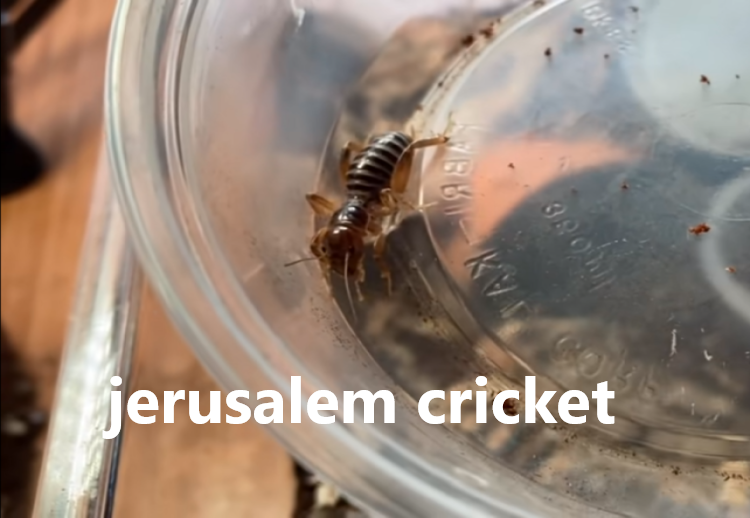The Jerusalem cricket, often misunderstood and occasionally feared for its appearance, is an intriguing insect with unique characteristics and behaviours. Known scientifically as Stenopelmatus, these insects are called “cricket Jerusalem” or “Jerusalem crickets.” Here’s a comprehensive look into the world of these fascinating creatures.
Physical Characteristics of Jerusalem Crickets
Jerusalem crickets are easily identifiable by their distinct physical features. They have six legs, two small eyes, and a robust, humpbacked body, similar to camel crickets. Their bodies are adorned with yellow and black stripes, and unlike other crickets, their rear legs are short and spun. Their large heads house powerful mandibles capable of cutting through plastic and fabric, making their bites painful if they feel threatened.
Unique Mating Behavior
Adult Jerusalem crickets exhibit a unique mating behaviour known as drumming. Both males and females produce this drumming sound by beating their abdomens on the ground, sending vibrations through the soil to attract mates. Each species has a distinct drumming pattern audible to humans up to 60 feet away. After mating, females often engage in sexual cannibalism, consuming the male. The female then lays her eggs in the soil, hatching into nymphs that moult multiple times over two to five years before adulthood. Adults typically live for two to six months.
Diet and Feeding Habits
Jerusalem crickets have a varied diet that includes plant roots, other insects, rotting plant material, and tubers such as potatoes. They feed on underground roots and tubers during the day and emerge at night to consume other bugs and decaying plants. This nocturnal feeding helps maintain soil health by breaking down organic matter.
Environmental Role and Garden Presence
While they might be alarming, Jerusalem crickets play a crucial role in their ecosystem. They help decompose plant materials, enriching the soil. Despite their presence in gardens, they are not considered pests as they are solitary and have a low reproductive rate. Their presence is more beneficial than harmful, aiding soil aeration and decomposition.
Size and Lifespan
Most Jerusalem crickets grow between 1.2 and 2 inches long, with some species reaching up to 3 inches. Their eggs are about 3 millimetres long and saucer-shaped. These crickets have a relatively long developmental period, with nymphs maturing into adults over several years.
What to Do if You Encounter a Jerusalem Cricket
If you find a Jerusalem cricket in your home or garden, it’s best to relocate it rather than harm it safely. These insects are not aggressive and do not pose a significant threat. Use an insect guidebook to correctly identify them and ensure they are not mistaken for more harmful pests. Remember, their presence is a sign of a healthy ecosystem.
Conclusion
With their distinctive appearance and unique behaviours, cricket jerusalem is a fascinating part of our natural world. Understanding their role and characteristics helps demystify these creatures and highlights their importance in maintaining ecological balance. Next time you encounter a Jerusalem cricket, you’ll know just how valuable these “cricket Jerusalem“ are to the environment.
FAQs About Jerusalem Cricket
Q: What is a Jerusalem cricket?
A: A Jerusalem cricket, also known as Stenopelmatus, is a large, flightless insect native to the western United States, Mexico, and Central America. Despite its name, it is not an actual cricket nor from Jerusalem.
Q: Why are they called Jerusalem crickets?
A: The origin of the name needs to be clarified. One theory is that the name “Jerusalem“ was used as an exclamation of surprise when people encountered the insect. Another theory suggests a mix of Navajo and Christian terminology influenced the name.
Q: What do crickets jerusalem look like?
A: Jerusalem crickets have a distinctive humpbacked body with yellow and black stripes, large heads, and strong mandibles. They have six legs, two small eyes, and short, spiny rear legs.
Q: Are crickets jerusalem dangerous?
A: While their bite can be painful, Jerusalem crickets are not evil and do not threaten humans significantly.
Q: What do crickets jerusalem eat?
A: They feed on plant roots, other insects, rotting plant material, and tubers such as potatoes. They primarily eat underground during the day and come out at night to feed on decaying plants and other insects.
Q: How do Jerusalem crickets reproduce?
A: Jerusalem crickets produce a drumming sound during mating by beating their abdomens on the ground. After mating, females lay eggs in the soil, which hatch into nymphs that moult multiple times over several years before adulthood.
Q: How big do Jerusalem crickets get?
A: Most Jerusalem crickets grow between 1.2 and 2 inches long, with some species reaching up to 3 inches.
Q: Where do cricket jerusalem live?
A: They prefer dark, moist environments and are often found in gardens, under rocks, or in soil. They are nocturnal and spend most of their time underground.
Q: How long do cricket jerusalem live?
A: Jerusalem crickets have a developmental period of two to five years before adulthood and typically live as adults for two to six months.
Q: Are crickets jerusalem harmful to gardens?
A: crickets jerusalem are not considered garden pests. They help decompose plant materials, enriching the soil. They are beneficial to the environment and play a role in maintaining soil health.
Q: How can I get rid of Jerusalem crickets?
A: If you find a cricket jerusalem, it’s best to relocate it safely. They are solitary creatures with a low reproductive rate, so their presence does not indicate an infestation. Use an insect guidebook to correctly identify them and ensure they are not mistaken for more harmful pests.

